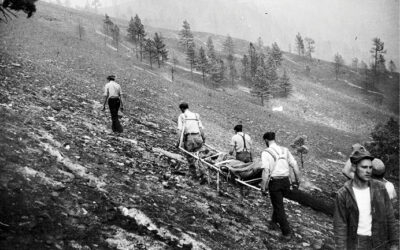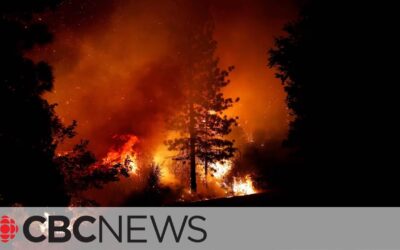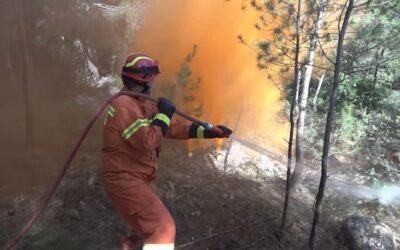The firefighter’s firefighter
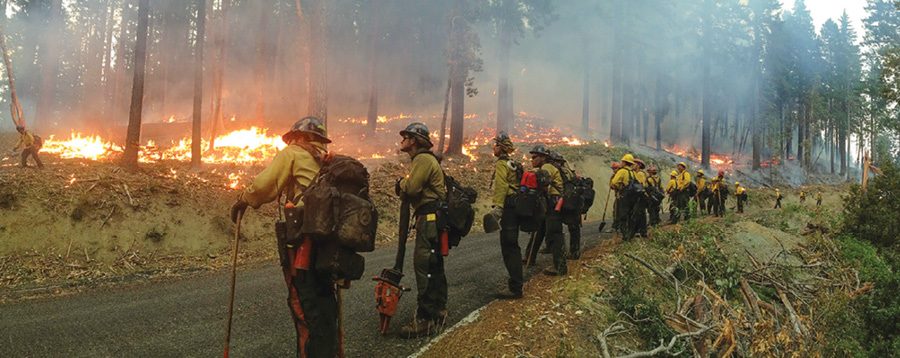
Panorama of the Geronimo Interagency Hotshot Crew as they keep watch on their burnout along a forest road. The Geronimo Hotshots are from the San Carlos Apache Tribal Natural Resources Program, in San Carlos, Arizona. (USDA Photo by Lance Cheung.)
By Dena Ali | FireRescue Magazine Volume 13, Issue 3
Effective firefighting is challenging and requires excellence in fitness, quick decision-making skills, and a willingness to sacrifice oneself for service to others. We are trained to risk a lot to save a lot. Our rewards, as structural firefighters, are many: fellowship, incredible home-cooked meals, downtime, days off, and more. In the eyes of our customers, we are running into burning buildings or rescuing people from car crashes and disasters. We’re superheroes to children and homeland defenders to adults.
As a structural firefighter, I often feel uncomfortable when approached and thanked for my service or given accolades for the risk my profession requires—primarily because I absolutely love the work I do and feel fortunate to have the ability to serve others. Additionally, while our profession is risky, the risks we take are calculated. No matter how difficult my 24-hour shift is, I know that I will be able to go home in the morning to recover. On the fireground, I’m reassured that I can only work as long as my self-contained breathing apparatus will allow, and there’s a rapid-intervention team (RIT) ready to rescue me if needed.
Not all firefighters enjoy these luxuries. During the wildfire season, wildland firefighters often work 16-hour days protecting communities while wearing heavy, heat-resistant boots and long-sleeve, heat-resistant shirts; carrying approximately 45 pounds of gear; and working in the most extreme weather conditions. Yet wildland firefighters are rarely recognized in the same light as structural firefighters. Though career wildland firefighters comprise less than 10 percent of the nation’s firefighters, their demands during the wildfire season far exceed the call volume of most urban firefighters.
Above and Beyond
The 2017 wildfire season was atypically demanding on crews. According to Bill Gabbert of “Wildfire Today,” preliminary data on the 2017 wildfire season indicate that wildfires burned about 9,781,062 acres, or 49 percent more than the 10-year average preceding the year. Ironically, the data also show a four percent drop in total fires for 2017. Additionally, as of August 11, 2017, 369 hand crews, 578 fire engines, and 141 helicopters, for a total of 15,000 personnel, were actively engaged in 83 active wildfires.1
While wildland firefighters face significant demands during the typical fire season, the expectations placed on smokejumpers, rappellers, and hotshots are even more demanding. These elite wildland firefighting crews must be in top physical condition, be willing to work in rough and remote terrain, and meet stringent physical qualifications. They face the daily danger of fire, as well as falling trees, poison ivy, snakes, heat stress, smoke inhalation, and rhabdomyolysis.
This article was written to provide insight into the world of wildland firefighting while also highlighting the work of United States interagency hotshot crews. These crews are made up of some of the most dedicated and selfless firefighters in the country, yet their efforts and sacrifices often go unnoticed. The article will also discuss current wildfire trends, hazards, and areas of focus to make wildland firefighting safer.
Hotshots are the elite “special forces” of the wildland firefighting world and, currently, there has been no shortage in demand for their services. They’re typically placed in remote areas inaccessible by vehicles and tasked with creating a fire line to stop advancing wildfire and protect communities. Despite technological advances, these hand crews remain the backbone of wildland fire suppression.
The dangers they face were tragically demonstrated on June 30, 2013, when 19 of the 20 Granite Mountain Hotshots were killed at the Yarnell Hill Fire in Arizona. Extreme weather conditions caused a 180-degree shift in wind and trapped the experienced crew. Poor radio communications made it nearly impossible to summon for help or to provide an accurate location to aircrews. Although they all deployed their fire shelters correctly, none survived because of the limitations of current shelter technology.
From this tragedy came better awareness of hotshot crews, their sacrifices, and their need for better protection. Between 2002 and 2012, an average of four wildland firefighters died each year in wildland fires in the United States.2 Additionally, the National Interagency Fire Center reported an average of 19 wildland firefighter deaths annually, across all activities including training.
What Sets Hotshots Apart?
Drought, climate change, and a growing wildland-urban interface (WUI) have created perfect conditions for wildfire growth and the need for experienced hotshot crews who are typically placed in more difficult, dangerous, and stressful assignments. Several agencies oversee wildland fire programs that range from seasonal employment to more specialized work. According to the United States Forest Service (USFS), wildland firefighting is for people who “like hiking without trails; packing between 40 and 120 pounds of food, water, and supplies on their back; eating and sleeping in the dirt for days on end; and not having consistent showers.”3 Types of wildland firefighting jobs include fuel reduction crews, engine crews, hand crews, helitack crews, smokejumpers, prescribed wildland fire crews, wildland fire modules, and hotshot crews. There are currently 113 hotshot crews in the United States.
Most hotshots begin their career working seasonal employment on hand crews or type two teams. They get into wildland firefighting to earn extra cash through school or to gain fire service experience, and some find their true calling, ending up addicted to the adrenaline and brotherhood that wildland firefighting can provide. The elite hotshot crews are typically requested for large, high-priority fires and are assigned to remote areas with little logistical support.
Before being considered for a hotshot crew, candidates must meet high physical fitness standards and have previous wildland firefighting experience. The hotshot crews are made up of a unique breed of people who love the long hours and physical demands of the job. They are the epitome of the American firefighter: dedicated, fit, passionate, and love working with a team. As reported by Brendan McDonough, the lone Granite Mountain Hotshots survivor, fallen Granite Mountain Hotshot Robert Caldwell’s famous quote was, “I’d rather die in boots than live in a suit.”4 There is a certain beauty and wonder when you see a hotshot crew out on the line hiking to their next assignment. Their most revered traditions that have been maintained since their inception include sacrifice, order, structure, and brotherhood.
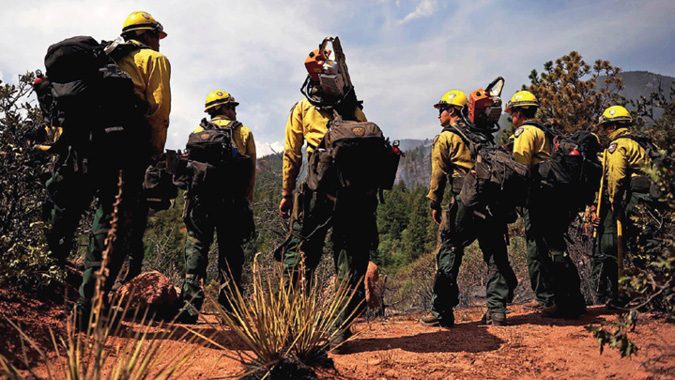
Members of the Vandenberg Air Force Base (CA) Hotshots prepare to cut a fire line in the Peregrine neighborhood of Colorado Springs, Colorado, on June 28, 2012. (U.S. Air Force photo by Master Sgt. Jeremy Lock.)
Basic Fitness Requirements
If one type of firefighter can be compared to a professional athlete, it’s a hotshot. Using the Pulaski or Chingadera tool to build a fire line demands incredible aerobic stamina and anaerobic capacity. Sawyers have one of the most demanding jobs on the fire line, as they have to get out front and clear a way for the rest of the crew while remaining constantly aware of the danger involved with their work.
During the fire season, hotshots are expected to work 16-hour days for two weeks straight, and those long hours are spent hiking steep and complex terrain while carrying the tools, food, and water on their backs to build fire lines between an encroaching fire and a community. There have been several fires requiring the crews to work for 30 hours straight to protect entire communities.
According to Brent Ruby, director of the University of Montana’s work physiology department, front-line wildland firefighters burn between 4,000 and 6,500 calories and need seven to 10 liters of water every day.5 Hotshots often work in inaccessible areas and are seen as a last hope to prevent fire spread to communities. Because of the demanding requirements, this is a career few people can do and, as such, they are required to complete a grueling fitness test before being selected. The test includes the following:
• Pack test (three-mile hike while carrying 45 pounds).
• Mile and a half run in less than 10:45.
• 40 sit-ups in less than 60 seconds.
• 25 push-ups in under 60 seconds.
• Perform a minimum of four chin-ups (depending on body weight).
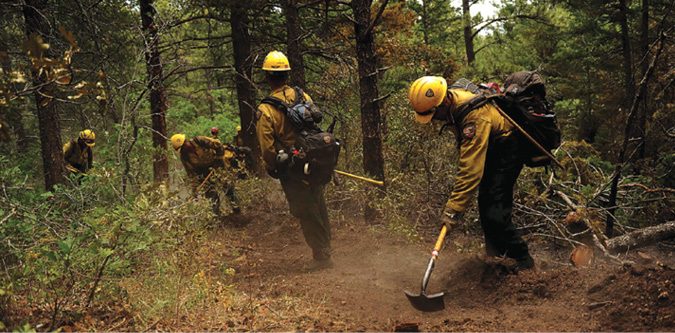
Firefighters from the Vandenberg Air Force Base (CA) Hotshots cut a fire line in the Mount Saint Francois area of Colorado Springs, Colorado, while helping to battle several fires in Waldo Canyon on June 28, 2012. (U.S. Air Force photo by Master Sgt. Jeremy Lock.)
Nutritional and Medical Challenges
As mentioned, front-line firefighters burn upward of 6,500 calories a day, and their bodies require three gallons of water daily to replenish what they exert while hiking and building fire lines. Because they are deployed for 14 days with little downtime, a need for convenience can lead to poor nutritional choices. While in the field, many hotshots survive on processed foods, meals ready to eat, donuts, energy drinks, and chew.
Another concern for wildland firefighters is rhabdomyolysis, the breakdown of muscle fibers that releases muscle fiber contents into the bloodstream. Rhabdomyolysis is a serious syndrome and requires hospitalization to prevent irreversible kidney damage. Strenuous and unaccustomed exercise is a common cause of rhabdomyolysis. There were seven confirmed cases of rhabdomyolysis during the 2016 fire season, and they all occurred in May and June (most occurred during physical training and not active firefighting). While there are no standard symptoms, firefighters with rhabdomyolysis experience a combination of the following symptoms: shakiness, elevated temperature, paleness, no sweat, swollen arms, dark tea-colored urine, cramping in legs, stomach pains, dehydration, and soreness. Most people diagnosed with rhabdomyolysis reported a unique cramping they had never felt before. All wildland firefighters should be taught the dangers of rhabdomyolysis and the early symptoms of onset.
In addition to heat stress, hotshots are chronically exposed to toxic air without the benefit of supplied air.
The Toll It Takes
During the extended wildfire season, hotshots are deployed away from home for extended periods of time, upward of 28 days. They have little downtime and they physically perform day in and out while camping in the wilderness. In a six-month period, these crews may only make it home six times for just a couple of days at a time. This combination of factors can take an extreme toll on their bodies, minds, and families. A recent report issued by Two More Chains found a rise in suicide rates among the wildland fire community.
According to Vicki Minor, executive director of the Wildland Firefighter Foundation, in 2016, 13 wildland firefighters took their own lives, in addition to the 13 who died in the line of duty. Suicide is not unique to wildland firefighters; it’s a recognized problem among all first responders. One of the biggest contributors to suicide in public safety is the stigma that is associated with help-seeking behavior and a feeling of responsibility responders feel they must maintain. Emergency responders are the ones who are called when others are in crisis and, over time, they develop a perception that they cannot show weakness to their peers or family. According to Miranda Stuart, fire operations specialist with the National Park Service, “Part of this stigma in wildland firefighting is the perception that we are tough. We hike up mountains take on raging fires, run chainsaws, and must be in top physical shape. Weakness is not tolerated in our society very well. I see this all the time.”6
For elite hotshots, this risk is compounded by their elite status. Fortunately, suicide has been recognized by the USFS and the United States Fish and Wildfire Service, and both are collaborating with several industry leaders to bring about awareness and prevention resources such as peer support to help address the rising rates of suicide among wildland firefighters.
Since the 1970s, the total area burned in the western United States each year has tripled, and the number of fires greater than 10,000 acres has increased sevenfold. (4) Additionally, the fire season has increased from five months to seven-plus months since 1989 (4). Since 1994, 400 wildland firefighters have died in action and 40,000 homes have been lost to fire (4). According to the USFS, between 1995 and 2015 the cost of wildfire operation increased from 16 percent to 50 percent of the Forest Service’s annual budget. These costs are predicted to increase to 67 percent by 2025. To manage the rising costs of fire suppression, the forest service has reduced forest restoration projects designed to decrease the threat of wildfires, resulting in a viscous cycle of increased wildfire risk.7 A solution proposed to Congress is to classify wildfires as natural disasters so that the USFS can receive emergency funds for these catastrophic events without reducing funding for prevention or restoration.
Third Generation Fire Shelter
Not only do hotshots have little protection from escaped fires, but they also don’t have RITs standing by for rescue. Their only protection is their education, training, fire-resistant clothing, and fire shelter. The second-generation fire shelter approved by the USFS has been standard equipment for wildland firefighters since 2002. According to the Forest Service, these shelters have a capacity to withstand approximately 500°F. That’s the temperature at which the weakest component of the shelter, the adhesive that binds the inner and outer layer, starts to fail. Once the adhesive fails, the outer layer can easily be removed by wind. Additionally, the foil outer layer disintegrates at about 1,300°F.
North Carolina State University is currently working under a Federal Emergency Management Agency grant to produce a more effective fire shelter. The university’s Department of Forestry and Environmental Resources is working closely with the College of Textiles, Textile Protection, and Comfort Center (T-PACC) on the project. The team feels confident that it can produce a third-generation fire shelter that will have the ability to prevent another loss like the Granite Mountain Hotshots. NASA’s Langley Research Center is simultaneously working with the USFS to produce the third-generation fire shelter. The goal is for the USFS to select a better fire shelter in 2018.
Making Future Hotshots Safer
Improved shelter technology is an obvious direction for preventing future loss of life of wildland firefighters. However, Brendan McDonough fears that better equipment will result in firefighters taking more risks and pushing deeper into fires. (4) Instead, he advocates for equipment that will benefit wildland firefighters in other ways, such as a locator that continuously transmits the hotshot’s location. According to McDonough, an incident management team sitting remotely would be able to have an up-to-the-second visual of every hotshot while also keeping an eye on the fire and changing weather conditions. With eyes on the crews as well as the conditions, they could more quickly warn endangered firefighters and notify nearby pilots who could drop retardant to assist them.
Before deploying their shelters, the Granite Mountain Hotshot crew called for an air attack. However, because of poor radio communications, the pilot was unable to copy their radio traffic or locate the crew in time to provide protection. Satellite emergency notification devices (SENDs), which use satellite signals when there is no cellular service, might have saved these firefighters. SENDs also have an SOS button that allows a firefighter to indicate he is in trouble and transmit his exact location. (4) According to McDonough, every wildland firefighter, including hotshots, should be outfitted with a SEND or similar device. Improved locator and SEND device technology should be a focus area.
Although wildfires have increased, firefighters are losing their lives, and homes are being destroyed, the USFS is budgeting most of its money to the ever-increasing suppression needs rather than prevention and better technology. Allowing the Forest Service to use emergency funds reserved for natural disasters can help change these spending priorities. Bipartisan pressure on Congress is underway with provisions to streamline projects for thinning forests and reducing the fire threat across our national forests. The ever-growing WUI must be addressed as it further endangers the firefighters whose duty it is to protect those communities. Increased taxation of WUI residential areas without appropriate defensible space could be devoted to improving wildland firefighter technology.
Increasing Recognition
In closing, hotshots are a firefighter’s firefighter; they’re fit, skilled, highly motivated, and positive. During the fire season, they sacrifice their comfort and safety to help protect endangered communities. Their efforts are rarely recognized, yet the risks they face are significant. While the increased demand for their services has placed them at greater risk, it is also leading to increased recognition. Hope exists because the recognition of these risks and efforts is also leading toward an added focus on improving technology aimed at keeping them safer.
For more information on this important topic and resources for prevention, please see the Spring 2017 issue of Two More Chains, www.wildfirelessons.net/viewdocument/two-more-chains-spring-2017-1 Rising Costs of Wildfire Operations.
References
1. Gabbert, A. B., “15,000 firefighters are battling 83 wildfires in the United States,” August 11, 2017, retrieved August 16, 2017, from http://wildfiretoday.com/2017/08/11/15000-firefighters-are-battling-83-wildfires-in-the-united-states/.
2. Caton, Sara E., Raquel S. P., Hakes, Daniel J. Gorham, Aixi Zhou, and Michael J. Gollner, “Review of Pathways for Building Fire Spread in the Wildland Urban Interface Part I: Exposure Conditions.” Fire Technology 53.2 (2016): 429-73. Web.
3. National Fire Fighter Wildland Corp., July 29, 2015, retrieved August 08, 2017, from www.nationalfirefighter.com/blog/Types-of-Wildland-Firefighter-Jobs.
4. McDonough, B., and Talty, S., Granite Mountain: The Firsthand Account of a Tragic Wildfire, Its Lone Survivor, and the Firefighters Who Made the Ultimate Sacrifice, New York: Hachette, 2016.
5. Bush, E., “Type of person drawn to wildland firefighting might be called a ‘tactical athlete,’” August 21, 2015, retrieved from www.seattletimes.com/seattle-news/northwest/type-of-person-drawn-to-wildland-firefighting-might-be-called-a-tactical-athlete/.
6. Keller, P., “Suicide in the Wildland Fire Service,” Two More Chains Vol 7 Issue 1, Spring 2017.
7. Bonnie, R., Rey, M., “We worked for Bush & Obama: Here’s a bipartisan solution to America’s wildfire problem,” August 11, 2017, www.certusnews.com/life/We-worked-for-Bush-%26-Obama—Here’s-a-bipartisan-solution-to-America’s-wildfire-problem.ry7dO37ovW.html.

Dena Ali is a captain with the Raleigh (NC) Fire Department and intermediate with Wake County EMS. Prior to becoming a firefighter, she served five years as a police officer in North Carolina. Ali has a degree from North Carolina State University. She is a graduate student at UNCP, and her research focuses on firefighter suicide. Ali taught her class on suicide prevention at FDIC International 2017. She is an avid cyclist and founding member of the Carolina Brotherhood. Ali also serves as an advocate for 555 fitness.

